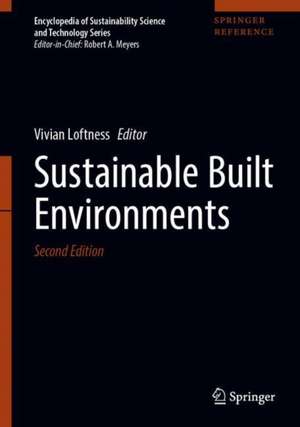Sustainable Built Environments: Encyclopedia of Sustainability Science and Technology Series
Editat de Vivian Loftnessen Limba Engleză Hardback – 23 sep 2020
This volume in the Encyclopedia of Sustainability Science and Technology, Second Edition, describes the breadth of science and engineering knowledge critical to advancing sustainable built environments, from architecture and design, mechanical engineering, lighting, and materials to water and energy, public policy, and economics. Covering both building, landscape and green infrastructure design and management, detailed consideration is given to how the building sector, the biggest player in the energy use equation, can minimize energy demand while providing measurable gains for productivity, health, and the environment. With a focus on the environmental context, the reader will understand how sustainable design merges the natural, minimum resource conditioning solutions of the past (daylight, solar heat, and natural ventilation) with the innovative technologies including nature-based solutions of the present. The desired result is an integrated “intelligent” and as socially “just as possible” system that supports individual control with expert negotiation for resource consciousness.
Din seria Encyclopedia of Sustainability Science and Technology Series
- 18%
 Preț: 2117.76 lei
Preț: 2117.76 lei - 18%
 Preț: 1851.77 lei
Preț: 1851.77 lei - 18%
 Preț: 2113.02 lei
Preț: 2113.02 lei - 24%
 Preț: 1601.27 lei
Preț: 1601.27 lei - 24%
 Preț: 1606.87 lei
Preț: 1606.87 lei - 24%
 Preț: 1495.40 lei
Preț: 1495.40 lei - 24%
 Preț: 2606.67 lei
Preț: 2606.67 lei - 24%
 Preț: 2364.25 lei
Preț: 2364.25 lei - 24%
 Preț: 1832.19 lei
Preț: 1832.19 lei - 24%
 Preț: 1598.85 lei
Preț: 1598.85 lei - 24%
 Preț: 2094.87 lei
Preț: 2094.87 lei - 23%
 Preț: 1559.82 lei
Preț: 1559.82 lei - 5%
 Preț: 1857.53 lei
Preț: 1857.53 lei - 24%
 Preț: 1577.59 lei
Preț: 1577.59 lei - 32%
 Preț: 3971.64 lei
Preț: 3971.64 lei - 26%
 Preț: 2631.22 lei
Preț: 2631.22 lei
Preț: 1782.10 lei
Preț vechi: 2344.87 lei
-24% Nou
Puncte Express: 2673
Preț estimativ în valută:
340.100€ • 357.31$ • 281.90£
340.100€ • 357.31$ • 281.90£
Carte tipărită la comandă
Livrare economică 08-14 aprilie
Preluare comenzi: 021 569.72.76
Specificații
ISBN-13: 9781071606834
ISBN-10: 1071606832
Pagini: 713
Ilustrații: XXI, 713 p. 388 illus., 310 illus. in color.
Dimensiuni: 178 x 254 mm
Greutate: 1.95 kg
Ediția:2nd ed. 2020
Editura: Springer Us
Colecția Springer
Seria Encyclopedia of Sustainability Science and Technology Series
Locul publicării:New York, NY, United States
ISBN-10: 1071606832
Pagini: 713
Ilustrații: XXI, 713 p. 388 illus., 310 illus. in color.
Dimensiuni: 178 x 254 mm
Greutate: 1.95 kg
Ediția:2nd ed. 2020
Editura: Springer Us
Colecția Springer
Seria Encyclopedia of Sustainability Science and Technology Series
Locul publicării:New York, NY, United States
Cuprins
Part I: Sustainable Built Environment.- Bioclimatic Design.- Daylighting Controls, Performance, and Global Impacts.- Facades and Enclosures, Building for Sustainability.- Geothermal Conditioning: Critical Sources for Sustainability.- Indoor Environmental Quality and Health Improvement, Evidence-Based Design for.- Natural Ventilation in Built Environment.- Passive House (Passivhaus).- Passive Solar Heating in Built Environment.- Rating Systems for Sustainability.- Regenerative Development and Design.- Resource Repletion, Role of Buildings.- Sustainability Performance Simulation Tools for Building Design.- Sustainable and Healthy Built Environment.- Sustainable Built Environment, Introduction.- Sustainable Design and Construction, Integrated Delivery Processes and Building Information Modeling.- Sustainable Heating Ventilation and Air Conditioning.- Part II: Sustainable Landscape Design, Urban Forestry and Green Roof Science and Technology.- Biodiversity in Cities, Reconnecting Humans with Nature.- Green Infrastructure and Climate Change.- Green Roofs, Ecological Functions.
Notă biografică
Vivian Loftness FAIA, is an internationally renowned researcher, author, and educator focused on environmental design and sustainability, climate and regionalism in architecture, and the integration of advanced building systems for health and productivity.
At Carnegie Mellon University, Professor Loftness holds the Paul Mellon Distinguished Chair in Architecture, is one of 40 University Professors, and served a decade as Head of the School of Architecture. With over 30 years of industry and government research funding, she is a key member of Carnegie Mellon’s leadership in sustainability research and education and contributor to the ongoing development of the Intelligent Workplace – a living laboratory of commercial building innovations for performance.
Her collaborative research is captured in over 100 journal articles, book chapters, and books, as well in the 2013 and 2020 Springer Reference Encyclopedia of Sustainable Built Environments, for which she serves as Editor.
Professor Loftness has served on over 25 Boards of Directors, including EPA’s NACEPT, DOE’s FEMAC, and the National USGBC, AIA, and ILFI Boards. She has served on 12 National Academy of Science panels as well as the Academy’s Board on Infrastructure and the Constructed Environment and given four Congressional testimonies on sustainable design. Her work has influenced national policy and building projects, including the Adaptable Workplace Lab at the U.S. General Services Administration and the Laboratory for Cognition at Electricity de France.
Professor Loftness has been recognized as a LEED Fellow; a Senior Fellow of the Design Futures Council, the New Buildings Institute, and the Scott Energy Institute; and one of 13 Stars of Building Science by the Building Research Establishment in the UK. She received Awards of Distinction from AIA Pennsylvania and NESEA, holds a National Educator Honor Award from the American Institute of Architecture Students,and a “Sacred Tree” Award from the US Green Building Council. Professor Loftness is a Bachelor of Science and Master of Architecture from MIT.
Caracteristici
Shows how sustainable design is a collective process whereby the built environment achieves unprecedented levels of ecological balance through new and retrofit construction, with the goal of long-term viability and humanization of architecture and the inclusion of green and blue elements Covers the basic principles of sustainable landscape ecological management, from resource conservation, green infrastructure, built development, and environmental quality to social equity, human health and political participation Presents the design of flexible systems, integrated for comprehensive performance delivery Describes processes and patterns of both urban growth and shrinkage as a new and intertwined topic of urban systems research
